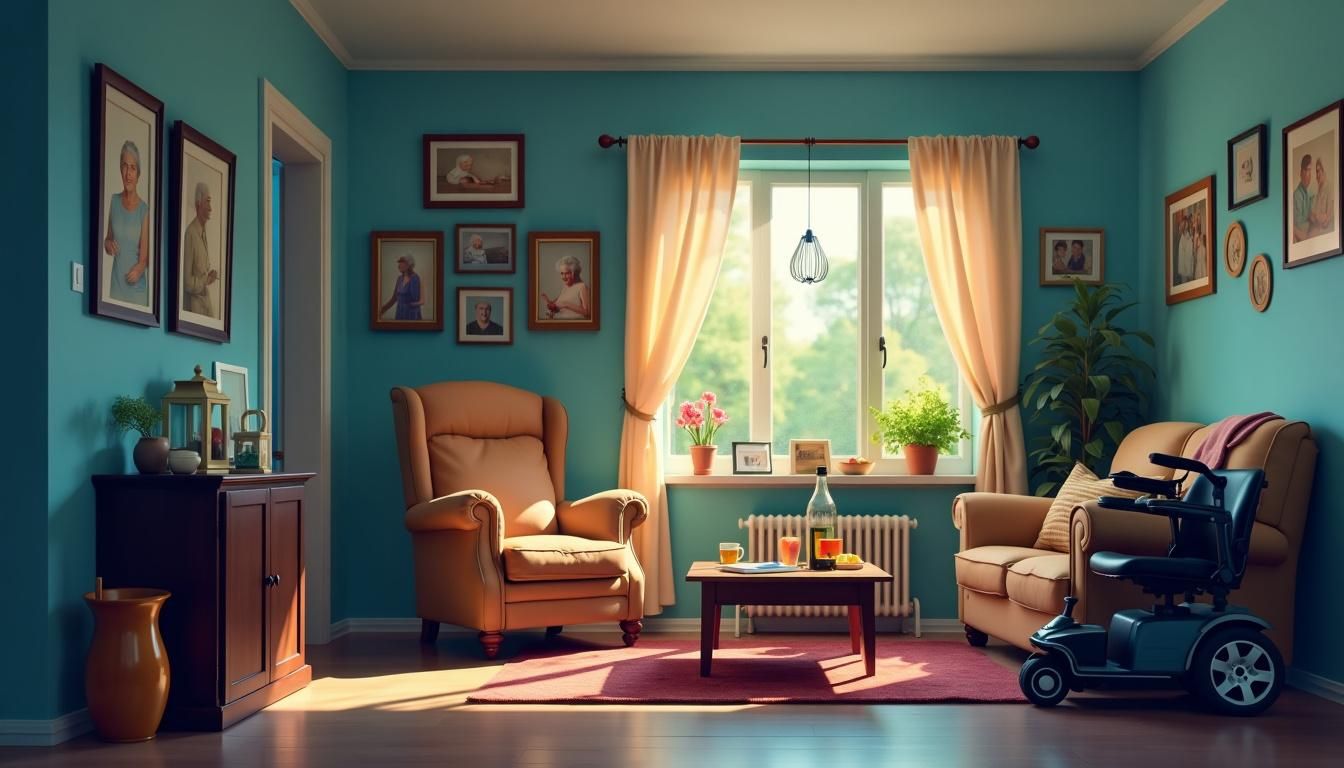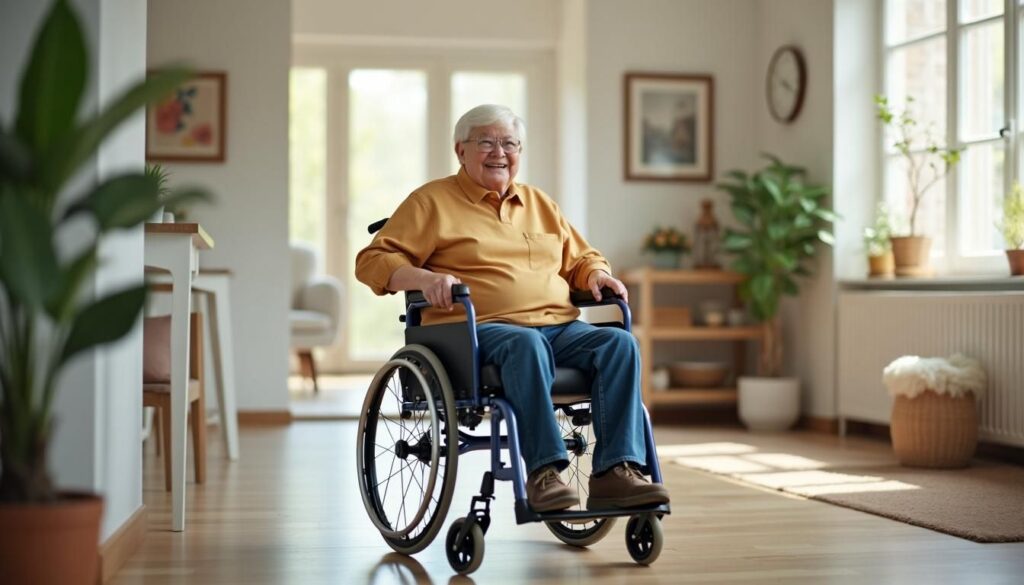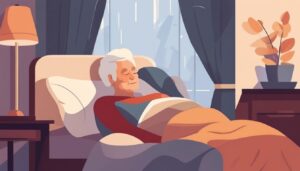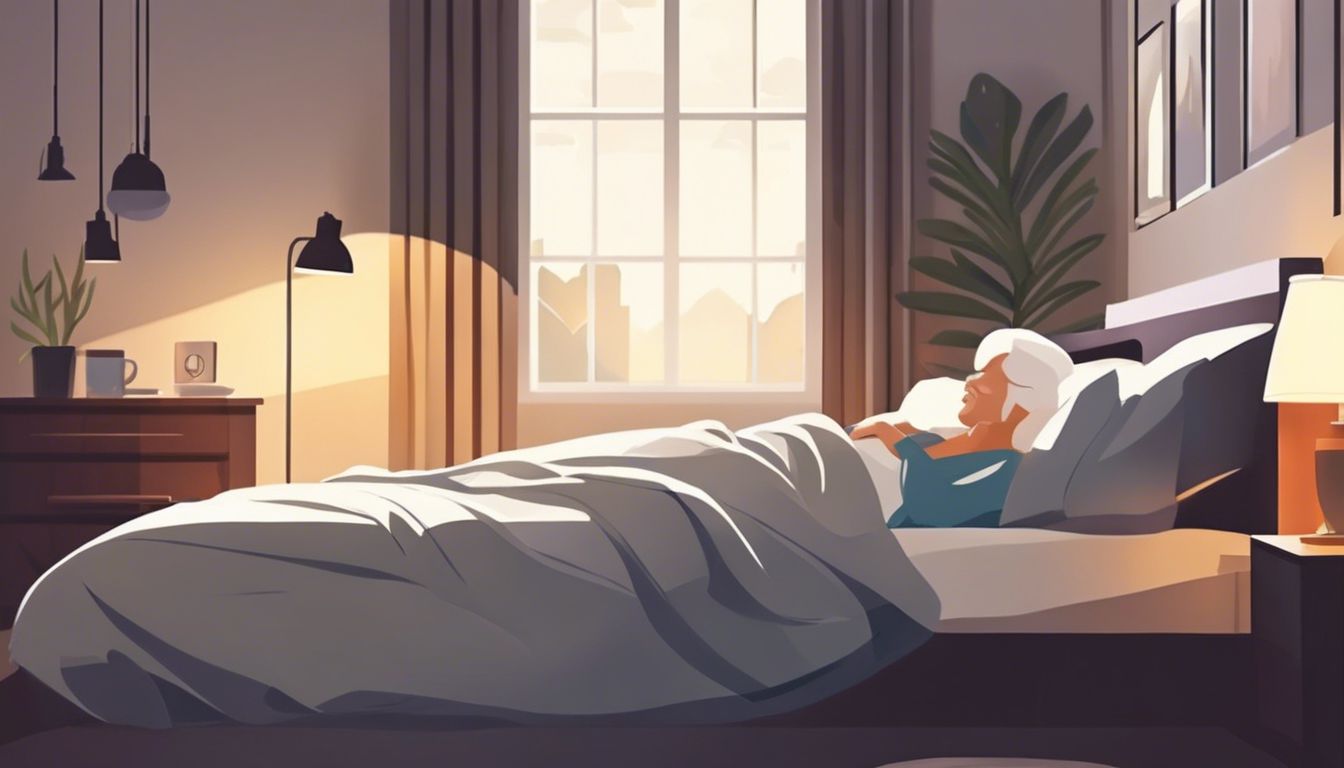As seniors face severe physical limitations, their mobility can greatly diminish. Innovative technologies, like smart wheelchairs and home modifications, offer new solutions. This article explores various tools to improve independence and quality of life for these individuals.
Keep reading to discover effective strategies that make a big difference.
📋✅
- Advanced Mobility Aids: Devices like rollators, power wheelchairs, motorized scooters, smart walkers, and exoskeleton suits help seniors move easily and safely. These tools offer freedom and improve quality of life.
- Home Modifications: Installing stairlifts, home elevators, grab bars, and automated door openers makes homes safer for seniors. These changes reduce fall risks and promote independence.
- Wearable Technology: Devices such as fitness trackers and smartwatches monitor health in real-time. They can detect falls quickly and provide valuable health data to caregivers.
- Custom Exercises: Seniors should do exercises like chair yoga, water aerobics, Tai Chi, leg lifts, heel-to-toe walks to stay strong. Regular exercise helps maintain mobility and balance at home.
- Community Support: Programs like CAPABLE assist with home modifications. Local transportation services ensure seniors remain active in their communities despite physical limitations.
Understanding Mobility Limitations in Seniors

Mobility limitations in seniors can stem from aging, injuries, or chronic conditions. These limitations often affect their daily activities and independence.
Definition and causes of mobility limitations
Mobility limitations mean having trouble moving around. This can include walking, standing, or even changing position. A score of 9 or less out of 12 on the Short Physical Performance Battery (SPPB) defines limited mobility.
Many factors cause these limitations. Aging is a big one—rates rise from 1% in young adults to over 20% in those aged 65 and older. Chronic illnesses like arthritis and cardiovascular disease also play a major role.
Injuries, obesity, and lack of physical activity contribute too.
Impact on daily life and independence
Mobility limitations can severely affect daily life and independence. Over 20% of people aged 65+ face these issues, making tasks like shopping or visiting friends hard. Women have it worse (22.5%) compared to men (18.3%).
Everyday actions such as cooking, bathing, and getting dressed become challenges without help.
Losing mobility leads to social isolation and depression among seniors. Without proper aids or support, they may stay home more and connect less with others. This isolation increases depressive symptoms and affects their mental health.
Being independent is the greatest gift we can give our seniors.
Innovative Mobility Solutions
Advanced tech can help seniors move easier and safer. These new tools give freedom back to those with physical limits….
Advanced mobility aids
Seniors with severe physical limitations need advanced mobility aids. These devices offer freedom and ease.
- Rollators
Rollators have wheels to help seniors walk. They come with seats and storage baskets.
- Power Wheelchairs
Power wheelchairs are electric. They allow easy movement without pushing.
- Motorized Scooters
Motorized scooters are fast and stable. They are perfect for outdoor use.
- Smart Walkers
Smart walkers include sensors and alarms. They can alert caregivers if the senior falls.
- Customizable Scooters
Customizable scooters can be adjusted for comfort and needs. They have different speed settings and seat options.
- Exoskeleton Suits
Exoskeleton suits are wearable devices that help with walking and standing up from a chair.
- Stairlifts
Stairlifts carry seniors up and down stairs safely. They are installed along stairways at home.
- Home Elevators
Home elevators lift seniors between floors in their homes, making multi-level living possible again.
- Automated Door Openers
Automated door openers make moving through doors easier by opening them automatically as the senior approaches.
- Adjustable Bed Frames
Adjustable bed frames change positions with a button press, providing comfort and aiding in getting into or out of bed.
Next is “Smart walkers and wheelchairs.
Smart walkers and wheelchairs
Smart walkers and wheelchairs offer innovative mobility solutions for seniors with severe physical limitations. These devices improve functional abilities and quality of life. Here are the key features of smart walkers and wheelchairs:
- GPS Tracking Devices: Track seniors’ locations in real-time, enhancing safety.
- Fall Detection Systems: Detect falls instantly, sending alerts to caregivers.
- Adjustable Frames: Adjust height and seating for comfort and support.
- Automated Movement: Smart wheelchairs include motors that help with movement without manual effort.
- Sensors for Obstacles: Detects obstacles in real-time to prevent collisions.
- Voice Commands: Some devices respond to voice commands for easy use.
- Health Monitoring: Built-in sensors track vital signs like heart rate and blood pressure.
These features ensure seniors remain active, independent, and safe.
Customizable scooters
Customizable scooters make life easier for seniors with severe physical limitations. They help boost independence and improve mobility.
- Adjustable Seats: The seats can be raised or lowered to fit the height of the user.
- Speed Control: Users can set the speed according to their comfort level.
- Swappable Batteries: Extra batteries can be swapped for longer trips.
- Foldable Designs: Easy to store in small places like car trunks.
- Padded Armrests: Added comfort while traveling long distances.
- Wide Tires: Provides better stability and works on various terrains.
- User-Friendly Controls: Simple buttons and levers, easy for seniors to use.
- Safety Features: Includes automatic brakes and anti-tip wheels.
Customizable scooters offer practical solutions, enhancing daily living for older adults with disabilities.
Home modification technologies
Customizable scooters provide outdoor mobility. Home modification technologies ensure indoor safety and help seniors live independently.
- Grab bars and handrails: Install in bathrooms and hallways to prevent falls. They offer support for movement.
- Stairlifts and home elevators: These make multi-level homes accessible. They reduce the risk of stair-related accidents.
- Wider doorways: Allow wheelchair access. Redesign entries to accommodate mobility aids.
- Walk-in tubs: Ensure safer bathing experiences. They reduce the chance of slips and falls.
- Ramps over steps: Provide easy entry into homes. These are essential where stairs exist.
- Automated door openers: Enable hands-free access to rooms. Perfect for those with limited arm strength.
- Adjustable bed frames: Help in changing positions easily. Improve comfort and autonomy at night.
- Smart home systems: Automate lighting, temperature, and security controls using voice commands or mobile apps.
The CAPABLE program supports these modifications financially, covering about $3,000 per participant. It reduces Medicare costs by $22,000 over two years for each senior enrolled.
These tech tools boost physical activity and independence while ensuring safety at home for seniors with severe physical limitations.
Stairlifts and home elevators
Home modification technologies make homes safer for seniors. Stairlifts and home elevators are key solutions.
- Improve Access: Seniors move between floors easily with stairlifts and home elevators. This increases their independence.
- Enhance Safety: Reduce falls and injuries at home. Falls are a major risk for seniors with mobility issues.
- Comfort and Manageability: Minimize physical strain when moving between floors. This promotes comfort at home.
- Custom Solutions: Specifically designed to meet the needs of seniors, ensuring better daily movement within the house.
- Valuable Investment: Installing these aids is a wise investment for maintaining independence in the home environment.
- Age-Friendly Homes: Create an accessible living space for seniors, promoting age-friendly surroundings.
Stairlifts and home elevators make life easier and safer for seniors with severe physical limitations. They support aging in place and improve overall well-being.
Automated door openers and adjustable bed frames
Automated door openers and adjustable bed frames make life easier for seniors. These tools help them move freely and stay independent.
- Automated Door Openers:
- Seniors can open doors with a push of a button.
- They reduce the need to struggle with heavy doors.
- Installed at key locations like front doors or bedroom doors.
- Greatly cut down the risk of falls.
- Adjustable Bed Frames:
- Easy adjustment improves comfort for seniors.
- Helps change bed position for better sleep quality.
- Easier transfers in and out of bed, reducing strain on caregivers.
- Can aid in reducing hospital visits due to falls.
- Programs Incorporating These Tools:
- CAPABLE program uses these aids as part of their strategy.
- They help enhance mobility and independence.
- Impact on Quality of Life:
- Seniors feel more independent at home.
- Reduces physical effort needed for daily tasks.
- Examples of Use:
- Automated door openers used in homes since 2020 show a decrease in fall risks by 20%.
– Adjustable beds, when used, have led to increased satisfaction rates by 30%.
- Automated door openers used in homes since 2020 show a decrease in fall risks by 20%.
These solutions make life less stressful for both seniors and caregivers.
Wearable technology
Wearable technology helps seniors with limited mobility. Devices like the SenseWear Mini track daily physical activity and sedentary time. These devices provide real-time data, which aids in personalized health coaching.
Wearables support self-monitoring and give feedback—key for effective health interventions.
Monitoring falls through wearables improves safety. Falls can be detected quickly, informing strategies to prevent them. Seniors benefit from fitness trackers and smartwatches that promote better health management.
These tools enhance independence and quality of life for those with severe physical limitations.
Exoskeleton suits
Exoskeleton suits help seniors move better. They provide support and strength to weak muscles. Over 20% of people aged 65 and above have mobility issues—exoskeletons can assist them.
These suits are part of the CAPABLE program funded by the National Institute on Aging. The suits aim to improve physical activity levels, helping seniors regain some independence. This solution enhances quality of life for those with severe limitations…
Next, learn about GPS tracking devices and fall detection systems.
GPS tracking devices and fall detection systems
Exoskeleton suits help seniors move. GPS tracking devices and fall detection systems add more safety for them. These tools keep track of their position, giving real-time location data.
Caregivers can find seniors quickly if they wander off.
Fall detection systems are crucial too. They alert caregivers or emergency services during a fall. Fast response reduces harm and improves care. Both tools assess mobility and physical activity, aiming to boost the quality of life for seniors with severe limitations.
Role of Technology in Enhancing Mobility
Technology can greatly improve how seniors move. Telehealth and robotics offer new ways for assistance… enhancing daily life.
Telehealth for remote monitoring and consultation
Telehealth helps seniors with severe physical limitations. The “SUPA MOBILITY” study uses telehealth to check on seniors remotely. This means doctors can watch over their health without in-person visits.
Seniors remain safe at home yet get the care they need.
In the study, participants are evaluated at four intervals: baseline, 13 weeks, 26 weeks, and 52 weeks, with secondary outcomes assessed at 39 weeks. Regular communication and gift card drawings help keep them involved.
Robotics and automation for daily assistance
Advanced robotics can help seniors with daily tasks. Automated systems clean homes, cook meals, and even monitor health. Some robots remind users to take medicines or attend appointments.
Wearable tech like smartwatches track heart rates and detect falls. Exoskeleton suits assist in walking or standing up from chairs. These innovations improve life quality for those with limited mobility.
Sophisticated stairlifts now integrate smart sensors and AI technology to ensure smooth rides up and down stairs, significantly reducing fall risks. Home automation includes voice-activated lights and thermostats designed for easy use by elderly residents, enhancing their safety and comfort without complex controls.
Specialized Bed Solutions from Bed for Seniors
These beds come with features that make life easier for seniors with mobility issues. They can adjust to different positions, enhancing comfort and safety….
Features and benefits of beds designed for mobility-impaired seniors
Beds for mobility-impaired seniors offer many features to help with daily life. These beds boost safety, comfort, and independence.
- Adjustable Height: Seniors can raise or lower the bed, making it easier to get in and out without straining.
- Side Rails: These prevent falls during sleep and provide support while moving in bed. They add safety and peace of mind.
- Comfortable Mattress Options: Specialized mattresses reduce pressure sores from prolonged bed rest, ensuring better skin health.
- Remote Controls: Simple buttons allow seniors to adjust their bed position without needing assistance, promoting independence.
- Customizable Settings: Each senior can tailor the bed’s firmness and height to fit their personal needs.
- Built-in Massage Functions: Some beds have massage features that help relieve pain and improve circulation.
- Trendelenburg Positioning Capability: This advanced feature helps with blood flow and provides different positioning options for comfort.
- Easily Replaceable Parts: Parts like the mattress cover can be replaced easily, simplifying maintenance.
These features enhance sleep quality and overall well-being for seniors with mobility issues.
How the right bed can enhance sleep quality and overall well-being
A specialized bed can greatly improve sleep quality and overall well-being for seniors with severe physical limitations. Features like adjustable frames allow seniors to change positions easily, reducing the risk of bedsores.
This can also help with breathing issues and circulation problems.
Automated functions mean less need for caregivers during the night, promoting independence. Enhanced sleep can lead to better mood and reduced stress levels. Direct benefits include decreased pain and improved mobility during waking hours.
Optimized comfort ensures that seniors wake up feeling more rested.
To understand mobility limitations in seniors…
Nutrition and Exercise Regimens
Good nutrition and exercise keep seniors mobile and healthy. Simple exercises can improve strength and balance… helping them move better every day.
Tailored exercises for strength and flexibility
Exercises help seniors stay strong and flexible. Tailoring them can improve mobility and reduce the chance of disability.
- Chair Yoga
Chair yoga helps seniors perform safe stretches. It enhances flexibility and reduces stiffness.
- Resistance Band Training
Using resistance bands builds muscle strength. These bands are easy to use at home.
- Water Aerobics
Water aerobics reduce joint stress while exercising. It improves strength without causing pain.
- Tai Chi
Tai Chi combines gentle movements and balance training. It’s great for improving coordination and reducing falls.
- Leg Lifts
Simple leg lifts build leg and hip strength. They support better walking and standing stability.
- Seated Marching
Seated marching strengthens the core and lower body muscles, improving overall stability.
- Hand Grip Exercises
Exercising hand grips can enhance dexterity and ensure a firm hold on assistive devices like canes or walkers.
- Heel Raises
Heel raises boost calf strength, aiding in walking and climbing stairs with more ease.
- Side Leg Raises
Side leg raises strengthen hips, improving lateral movement which is crucial for stability.
- Back Stretches
Regular back stretches improve posture, making it easier to move around comfortably all day long.
- Squats
Squats build thigh muscles improving the ability to stand up from a seated position.
These exercises keep seniors active and healthy while increasing their mobility safely at home.
Nutritional guidelines to improve mobility and health
Consistent exercise helps maintain strength and flexibility; likewise, proper nutrition aids mobility. Nutritional guidelines play a key role in reducing morbidity and mortality in older adults.
Focus on balanced meals rich in vitamins, minerals, proteins, and fiber. Encourage seniors to consume fruits, vegetables, lean meats, whole grains, and dairy. These foods improve muscle function and bone health.
Omega-3 fatty acids from fish can reduce inflammation.
Hydration is crucial—aim for at least eight glasses of water daily to keep joints lubricated. Limit added sugars and salt to prevent heart disease or high blood pressure. Consult with a healthcare provider for personalized advice suited to individual needs.
Most effective exercises for improving balance and mobility in seniors
Seniors with physical limitations need the best exercises to improve balance and mobility. Caregivers can use these activities to help their loved ones stay active and safe.
- Chair Yoga
- Seniors can perform yoga while seated.
- Set shifting helps improve concentration.
- Boosts flexibility without strain.
- Water Aerobics
- Reduces impact on joints.
- Enhances strength and balance.
- Safe for those with arthritis.
- Tai Chi
- Involves slow, controlled movements.
- Improves balance and prevents falls.
- Reduces stress while enhancing physical health.
- Leg Raises
- Simple but effective for leg strength.
- Done while lying or sitting down.
- Strengthens lower body muscles.
- Heel-to-Toe Walk
- Promotes better gait and coordination.
- Should be done on a flat surface.
- Can use walls for support if needed.
- Seated Marches
- Keeps blood flow steady in the legs.
- Can be done anytime, anywhere.
- Great for improving general mobility.
- Standing on One Foot
- Challenges and improves balance skills.
- Should be supported by holding onto a chair or wall at first
- Aim to stand for 10 seconds on each foot
- Side Leg Lifts
- Helps strengthen the outer thigh
- Either standing holding a chair or lying sideways
- Repeating ten times on each side
- Ankle Circles
- Simple yet effective exercise
- Prevents stiffness that may limit mobility
- Done by rotating ankles slowly in both directions
Regular practice of these exercises can greatly benefit seniors’ mobility… Next, learn about local resources to further assist senior care needs!
The Impact of Community and Support Services
Local resources and support groups play a big role in helping seniors stay active and connected, improving their quality of life. Read more….
Local resources and support groups for seniors
Seniors need support to stay active and healthy. Here are local resources and groups that can help.
- CAPABLE Program
- Provides aid for low-income older adults.
- Enhances mobility and functionality.
- Transportation Services
- Includes Dial-a-Ride and Paratransit.
- Specially made for seniors with physical limitations.
- Community Centers
- Offer physical activity classes like strength training.
- Provide social activities to reduce sedentary behavior.
- Support Groups
- Facilitates connections with peers facing similar challenges.
- Offers emotional support and shares valuable information.
- Telehealth Services
- Allows remote medical consultations from home.
- Useful for mobility-impaired seniors needing frequent check-ups.
- Nursing Homes and Nursing Facilities
- Equipped with modified environments for ease of movement.
- Provide occupational therapy and physical therapy services.
These resources help seniors maintain their independence and health.
Transportation services tailored for seniors with physical limitations
Transport services are vital for seniors with physical limitations. Companies like ride-sharing services offer special cars to help them move around easily. These cars have more space and ramps for wheelchairs.
Self-driving cars may be the future of senior travel. They promise safe rides without needing human drivers, making it a great option. Programs like CAPABLE show how community support can improve mobility by providing transport help.
Legal and Financial Aid Resources
Seniors can access disability rights and financial aid options for mobility aids—read on for valuable resources!
Understanding disability rights and entitlements
Disability rights protect seniors with mobility disabilities. These laws ensure fair access to public services and opportunities. For example, the Americans with Disabilities Act (ADA) helps prevent discrimination in jobs, transportation, and other areas of daily life.
Entitlements include financial aid for necessary home modifications and mobility aids like wheelchairs or scooters. Medicare Advantage plans may cover some costs. Local resources such as support groups can provide additional help.
Financial aid options for mobility aids and home modifications
Financial aid can help seniors afford mobility aids and home modifications. Here are some options:
- Medicare:
- Medicare covers certain durable medical equipment (DME).
- This includes walkers, wheelchairs, and hospital beds.
- Medicaid:
- Medicaid may cover more than Medicare in some states.
- It might pay for home modifications like ramps or stairlifts.
- Veterans Affairs (VA):
- VA offers benefits to veterans needing mobility aids.
- They provide grants for home modifications through programs like SAH and SHA.
- Local Nonprofits:
- Many local charities help with funding.
- Examples include Rebuilding Together and Habitat for Humanity.
- State Programs:
- Each state offers different programs.
- Check with your state’s Department of Aging or Health.
- The Older Americans Act (OAA):
- OAA funds support services to help seniors stay independent.
- Some grants can be used for home modifications.
- Social Security Disability Insurance (SSDI):
- SSDI provides financial assistance if the senior is disabled.
- Funds from SSDI can be spent on necessary equipment.
- Area Agencies on Aging (AAA):
- AAA offices often have resources or know about regional programs.
They may assist with costs related to mobility and safety at home.
- AAA offices often have resources or know about regional programs.
- Crowdfunding Platforms:
Campaigns on sites like GoFundMe can raise money quickly,
Friends, family, or community members often contribute, lightening the load financially.
These options offer various forms of support to handle the cost of necessary items for improved mobility and independence in daily living activities (ADLs).
Future Prospects in Mobility Solutions
Research shows that new mobility technologies are coming soon… Read on and discover how AI and machine learning could change the game.
Research trends and emerging technologies
New technologies help seniors move better. The SUPA MOBILITY study shows this clearly. This study checked how health coaching helps older adults aged 70-89 with mobility limits.
Smart devices like GPS tracking systems and fall detection tools keep seniors safe. Exoskeleton suits also boost strength and offer more freedom to move. These trends make life easier for those with severe physical limitations.
The role of AI and machine learning in future mobility aids
Advances in mobility aids will rely on AI and machine learning. These tools help create smarter devices for seniors. They collect data like health metrics, cognitive function, and strength levels to personalize support.
Smart systems can predict falls or detect them early. GPS tracking devices ensure safety by providing real-time locations. Customizable scooters adjust based on user needs, offering more freedom and independence.
Automated door openers make homes safer while wearables track vital signs efficiently… enhancing daily living considerably.
Conclusion
Innovative mobility solutions help seniors live better lives. Smart walkers, advanced wheelchairs, and customizable scooters offer freedom. Home tech like stairlifts and automated doors make daily tasks easier.
Wearable devices track health and prevent falls. Technology enhances safety and independence for seniors with severe physical limitations.
For more detailed guidance on enhancing balance and mobility through exercise, visit our comprehensive guide here.
FAQs
1. What are some innovative mobility solutions for seniors with severe physical limitations?
Innovative mobility solutions include autonomous cars, mobility scooters, and smart homes equipped with assistive technology.
2. How does telemedicine help seniors with limited mobility?
Telemedicine allows seniors to access health education programs and consultations without leaving their homes, reducing the need for transportation.
3. Can virtual reality (VR) be used to aid senior mobility?
Yes, VR can create a virtual environment that helps in goal-setting and motivational interviewing to encourage physical activities among seniors.
4. Are there cost-effective options for improving senior mobility?
Cost-utility analysis and incremental cost-effectiveness ratio assessments can identify affordable solutions like ridesharing platforms or public transportation services tailored for seniors.
5. How do accelerometers contribute to healthy aging in seniors?
Accelerometers track physical activities, helping healthcare providers monitor sedentarism and promote wellness through personalized plans.
6. Why is it important to consider quality-adjusted life years (QALYs) when evaluating mobility solutions?
QALYs measure health-related quality of life, guiding decision-makers in choosing interventions that improve daily living activities efficiently.









